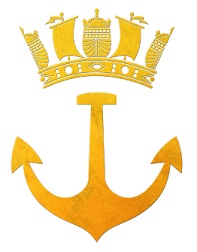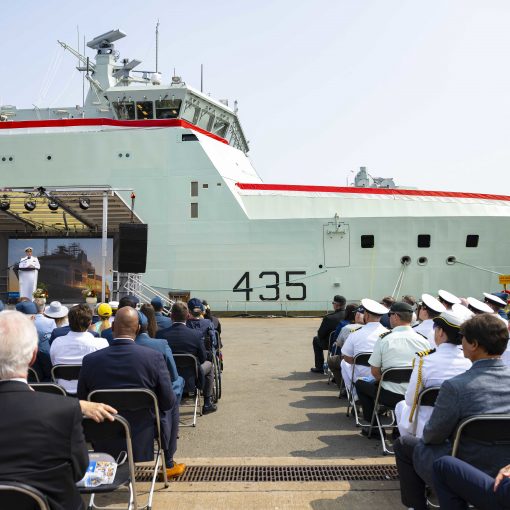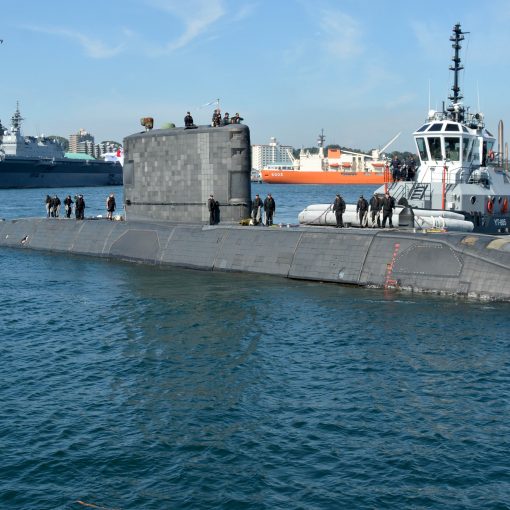By Dr. Ann Griffiths, 20 July 2025
There has been a lot of talk about threats and opportunities in the Arctic. And the Royal Canadian Navy now has all six of the Arctic and Offshore Patrol Ships. One would expect more activity in the Arctic. It’s also interesting that there has been much talk about, and much work done, to develop the port of Churchill, Manitoba. The railway line has had much work done to upgrade it, and the work force has been increased. The railway is looking at adopting some impressive technologies like drone inspections, artificial intelligence for data monitoring and GPS-tracked maintenance. Also, mineral storage facilities are being built in Churchill, and improvements are being made to the port itself. Modernization work at the port will include refacing of the wharf to support increased shipping activity and boosting the capacity to handle bulk cargo and accommodate a wider range of exports and imports. All this is facilitated by the Arctic Gateway Group, an Indigenous- and community-owned company that owns and operates the Port of Churchill. So Indigenous groups are onside. All of this makes Churchill look attractive for economic activity in the North. Perhaps we’ll see more RCN activity there as well.
Image: An undated photo of the Port of Churchill. Credit: Arctic Gateway Group






4 thoughts on “The Port of Churchill: Naval Possibilities?”
While this is all good news we should also consider the location.
Being inside the Hudson bay might seem ideal but there are some location worries — namely the bay is enclosed. Why is this a problem? Simply put, a determined SSN could potentially block passage to the area in war time as there’s only a few viable entrances / exits and these can be blockaded.
While Churchill’s ongoing port upgrades and northern economic development are good news from a commercial standpoint, suggesting it as a base for Royal Canadian Navy operations reflects a serious misunderstanding of military logistics, naval warfare and strategic geography.
Let’s start with the obvious: Churchill sits at the bottom of Hudson Bay, an enclosed body of water with only one narrow, easily monitored and blockaded exit, Hudson Strait. In any peer conflict scenario, a single enemy SSN (nuclear-powered submarine) or even long-range anti-ship mines could effectively bottle up any RCN force based there. That’s not strategic depth, that’s a naval cul-de-sac.
And yes, the railway line to Churchill , often held up as a lifeline , is part of the problem, not the solution. The line has a long and troubled history of washouts, permafrost damage, and reliability issues, and despite recent upgrades, it remains a single point of failure. In wartime or national emergency scenarios, that line would be highly vulnerable to sabotage, extreme weather, or supply chain disruptions. You cannot build a naval base dependent on one fragile rail corridor that’s frequently been knocked out for months at a time, it’s a logistical non-starter.
Now add in the limited navigation season (Churchill is ice-bound or ice-prone much of the year), lack of any existing naval infrastructure (no drydocks, fueling stations, or repair facilities), and lack of a support ecosystem (no trained personnel pool, no adjacent bases, no shore support). Even Nanisivik which is far north of Churchill, isn’t a full naval base but just a seasonal refueling facility, and it was years in the making for that limited role.
In peacetime, the Arctic and Offshore Patrol Ships (AOPS) can already patrol the region from Halifax and Esquimalt, supported as needed by fuel stops at Nanisivik or temporary forward staging. There is no operational need to base ships at Churchill when they can access the same waters more flexibly from existing bases without the logistical baggage.
So, while Churchill might make sense for grain shipments or mineral exports, it’s a strategic liability for the Navy. A base there would be:
– Geographically vulnerable
– Operationally inefficient
– Logistically unsupportable
– And easily isolated or blockaded in any credible wartime scenario
Churchill is a port of opportunity for commerce, but for the Royal Canadian Navy, it’s a dead end, both literally and strategically.
Hello Ted. Your observations on an RCN Naval Base in Churchill are spot-on! The only other commercial venture that I believe would be suitable at Churchill would be a future gas/oil pipeline from the West for transport natural gas/oil to European markets. To have an RCN Base there would be a death sentence for any fleet stationed at that port. It would not be just a cul-de-sac issue for the RCN & Canada, but a ‘kill-de-sac’ death wish for the Navy. What I will say however, is that any future modern 12 x AIP Submarine Fleet would be better suited with a Squadron of those boats (3-4) permanently stationed at a Port like Iqaluit that would service the Hudson’s Bay area much more strategically. Yes, having an RCN Base in Churchill would be a dead end, both literally and strategically for Canada and the RCN.
First priority for Port of Churchill should be improving resupply to Arctic hamlets where feasible.